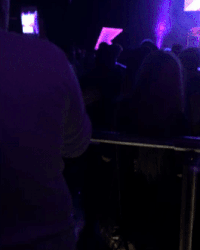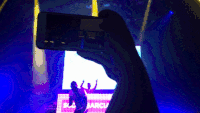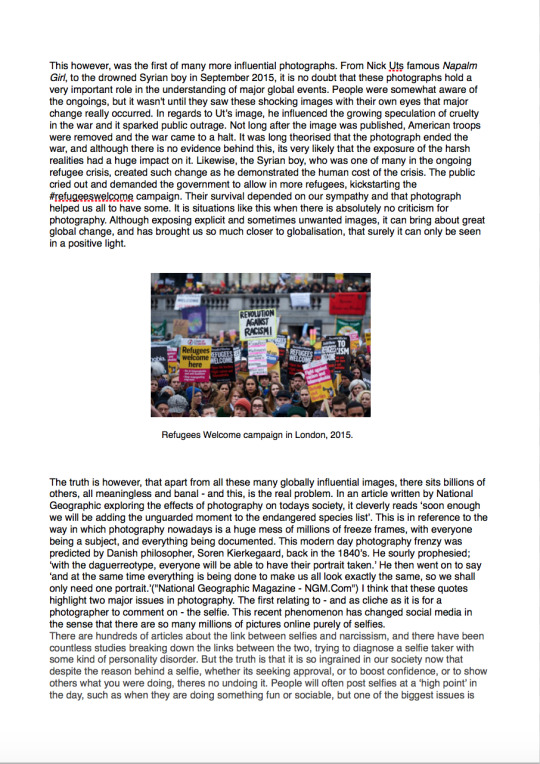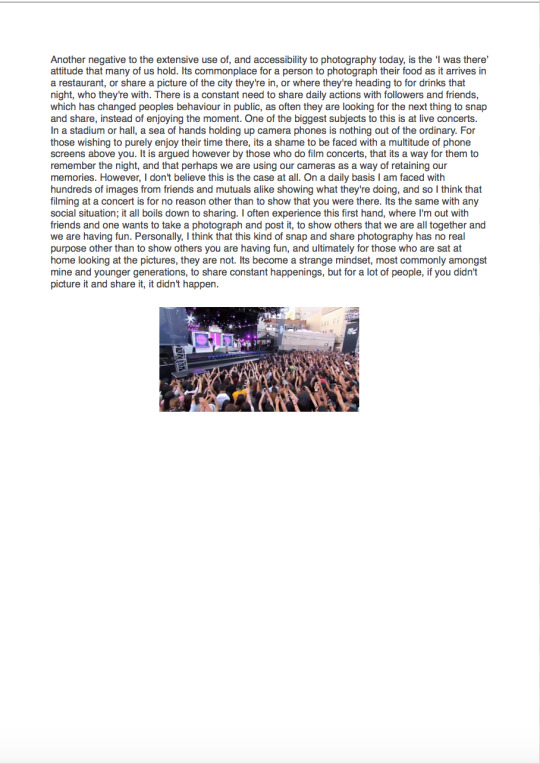Photo

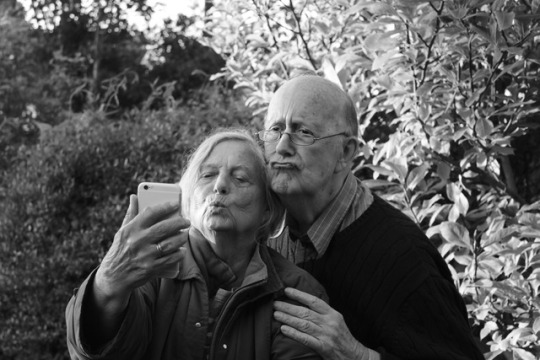
Here is a contact sheet and a final image from another photoshoot. I used both my grandparents and wanted to achieve them taking a selfie. They struggled to cooperate at first but this picture is my favourite as they both pulled these faces together without much instruction from me.
I think this photo is very satirical, and like to think that it will encourage people to do a double take, as the selfie looks strange when taken out of it usual context of a younger person.
0 notes
Photo
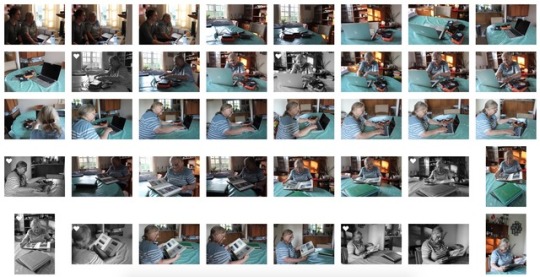
Here is my contact sheet from one of my photoshoots.
The aim of this photoshoot was to obtain 2 images that showed the comparisons between the vast amounts of photos we now own, to what we used to.
I wanted to use my grandmother for this, as she symbolises someone who would typically own a photoalbum. If we wanted to look at pictures from our grandparents youth, we would be able to find a select few in photo albums they may own. These days, we take so many photos a day, of banal and meaningless stuff, that our phones and computers are constantly cluttered with images. I think that in the future, if my grandchildren want to look at my photographs from now, I would have to look through endless hard drives and memory spaces to find certain photographs from a time period.
Therefore I have created a scene which demonstrates these two ideas, with the goal to have two contrasting images.


These two images were my most successful. Their framing and composition compliment each other, despite being different orientations.
I edited the images and made them both black and white, as I want most my images to be this way.
0 notes
Text
Saatchi Gallery Review
Yesterday I went to visit the ‘Selfie to Self Expression’ exhibition at the Saatchi Gallery. I felt as though this exhibition would tie in well with my final piece ideas, however it proved to be extremely relevant and many things I saw were very similar to what I had in mind for my project.
There were 5 different rooms which each demonstrated ‘the selfie’ in a different way, all with a satirical and humorous way. The first room displayed some of the first selfies; self portraits by classical artists. These consisted of Frieda Kahlo, Van Gogh, Francis Bacon etc. They were all presented on large screens, with a small phone next to it, in an Instagram style, where viewers could ‘like’ the photograph.

Another part of the exhibition was the installation of people videoing themselves. This was a large room with small videos projected onto the walls, and the sound of people talking playing from speakers.


Other parts of the exhibition had more of a satirical side to them, and taking the selfie out of context, making it almost laughable.

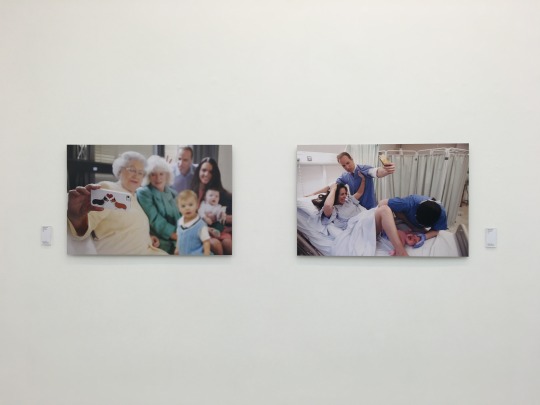
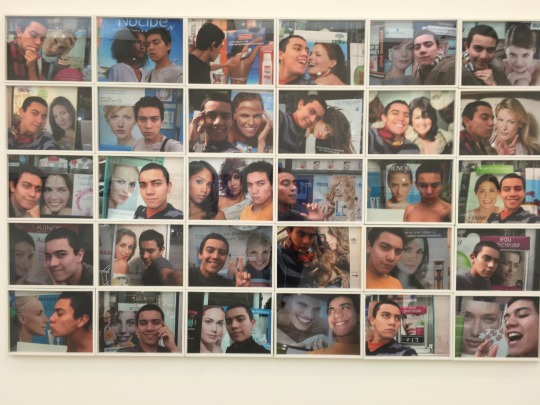
One part of the exhibition I particularly liked was the video installation by Simon Roberts. He created 2 films exploring how the swiss landscape becomes almost like a theatre backdrop for tourists. The films showed various tourists posing having their photo taken, but when looked at in this way, it seems very strange!!
0 notes
Text
Wording
Alongside my moving images and stills, I want to have a collection of wording and quotes to accompany the images and add more to them. Some of the quotes I've chosen so far are ones that have really resonated with me and that I personally say a lot.
1. “I dont think photography is dead, its just become lazy. People are taking lots of pictures but nobodys looking at them.”
2. “Soon enough we will be adding the unguarded moment to the endangered species list.”
3. “Smile for the camera”
4. “With the daguerreotype, everyone will be able to have their portrait taken”
5. “Smartphones change what people photograph”
6. “A narcissistic generation”
7. “A failure to achieve intimacy”
0 notes
Text
4 May
successfully managed to turned video clips into GIFs and convert to MOV. GIFs posted below are taken from a event I went to, where i focused on capturing people who were filming.
To make the GIFs I used a website called giphy.com, as they can generate the GIFS automatically from video. I then downloaded the GIF and converted it to an MP4 format so that it could be played as a film on loop.
Im happy with the way the GIF’s turned out, and think they highlight the issue of filming at live events clear.
0 notes
Text
13 April
My contextual essay is running very close beside my FMP, as I am exploring some of the issues we face with todays use of photography. For my final piece I want to demonstrate these issues in a physical way, through the use of photographs and film. I was unsure of which direction to head my work, but whilst writing this essay I have realised that I can combine all these issues into one body of work, and demonstrate multiple problems by using a multimedia approach and create an interactive piece.
0 notes
Quote
With the daguerreotype, everyone will be able to have their portrait taken.
Soren Kierkegaard
0 notes
Text
A Narcissistic Generation
although cliche for a photographer to comment on, one of the biggest ‘inventions’ of the last 5 years, is the selfie. It has had an enormous effect on society, and far greater than I think anyone can really understand.
Without getting too much into the already known details, the selfie came about, in my opinion, soon after the invention of flip screen digital cameras, where you could look at yourself while pointing the camera at your face. This saved many people from taking endless backwards facing pictures to try and get the face in the frame.

^ how the ‘selfie’ really took off.
There are hundreds of articles about the link between selfies and narcissism, and there have been countless studies breaking down the links between the two, trying to diagnose a selfie taker with some kind of personality disorder. But the truth is that it is so ingrained in our society now that despite the reason behind a selfie, whether its seeking approval, or to boost confidence, or to show others what you were doing, theres no undoing it. People will often post selfies at a ‘high point’ in the day, such as when they are doing something fun or sociable, but one of the biggest issues is not those who are posting the pictures, but those who are looking, because they begin to believe these high points to be someones whole life - which just isn't true. This extends beyond selfies in fact, and with the sharing of pictures in general, as when viewing them we never think to ourselves that these are only peoples highlights. Viewers are extremely likely to compare their day/mood/activities/friends to those that they are seeing in the pictures online, and are inevitably going to feel worse off for it.
To someone who is maybe not involved in any kind of social media, such as the elderly, I'm sure they struggle to understand a selfie, and too think that it is unusual or vain. I think that this is so important because, its only because were used to seeing it every day, that we assume it to be normal, however taking it out of context, it really is an unusual and very vain concept!
A very poignant quote I found, linking back to the 1800′s with the invention of the camera, or more specifically with the invention of the daguerreotype, is a great prediction of the 21st century. Soren Kierkegaard, a danish philosopher, sourly prophesised a banal fate for the newly popularised art of photography;
“with the daguerreotype, everyone will be able to have their portrait taken”
0 notes
Text
Photo albums to photo galleries
Another point of interest in terms of a potential negative aspect of a camera, is the vast majority of photographs that are taken on a daily basis. Originally, photography was introduced as a way of documenting historical events and raising awareness to the public. A photograph was a way of sharing something, which it still is today, but with so much less meaning now than before.
Photographs were precious, and never disposable. Someone wouldn't dare waste a shot by taking an image unless they were sure that it would work. Nowadays, with images being so disposable, its normal to take multiple images of the same thing, so that one can later go back and pick the most successful one. Although this is great for photographers in the sense that they have more chance of a successful image, by hoping that at least one will be good, it means that there are just millions and millions of photographs absolutely everywhere.
Long gone are the days of making photo albums, or perhaps looking through an album of your grandparents of their wedding, or your mums 5th birthday. What will our future be like? its hard enough finding an image from your family holiday to france in 2011 because its on one of the family members computer, or perhaps on one of the hardrives thats sitting in the cupboard with 1000′s of other photos on it. How are we going to show our children and their children our photos, because by then we will have so many hundreds of thousands, that we wont be able to find what we want, and it all becomes a massive clutter of essentially now pointless photographs.
As well as this, with many companies now owning ‘cloud’ type storage, where our photos can be uploaded to an online space and therefore retrieved from anywhere, we dont even own our images any more. This also loses all aspects of privacy, as since the photos are now online, they are subject to any kind of hacker or privacy invasion.
0 notes
Text
“I was there”
One issue that cameras have brought about is a society who has to document everything. There is very much a mindset amongst the majority of people of, ‘if you didn't take/share a photo, did it happen?’, and a strong urge to show people where you were, who you were with, and what you were doing.
This can have detrimental effects on the way that we experience social moments, as in a way, it takes the moment away. i.e. filming your favourite band at their gig, instead of fully enjoying being there, or stressing out whilst on the top of an amazing viewpoint, because you cant get a good enough picture of the view.
This also intruduces the question of, who are you taking the photo for? Perhaps its to act as a memory, or is it to show others? In that sense, we are changing our mindsets towards photography, that we are now taking photos with the idea of other peoples reactions in our minds, and no longer for ourselves.
0 notes
Text
“Camera Negatives”
the theme/title - the ‘negatives’ of the camera
...
“Camera Negatives”
0 notes


